This morning we took off for a couple-of-hour drive to the
southwestern coast, to Sicily’s biggest tourist site, Agrigento. The Valley of the Temples here is a UNESCO
World
Heritage Site, and with good reason.
It is another huge setting, some 3,000 acres total, and more ruins are
visible than were seen at Selinunte. It
lies on the shoreline, down the hill from a fairly ugly city also named
Agrigento, but you can pretty much just avoid looking in that direction and
find yourself drifting back in time.
This Doric Greek city was, at its prime in the fifth century B.C., the
fourth largest city in the known world with a population of at least 200,000. It is to some extent emblematic of most of Sicily
in that it has had a lot of owners. This
one location was held successively by
Greeks, Carthaginians, Romans,
Byzantines, Arabs, and Normans. This
pattern is repeated all over Sicily and the constant theme of conquest, never
being in control of their own destiny, seems to have made a pretty deep imprint
on the national psyche according to observers.
The remains today include an impressive line of temples
built on a ridge downhill of the ancient city.
One, called the Temple of Concord, is amazingly well preserved, due in
part to its conversion to a Christian basilica in the 6th century
A.D. and also because it was built on
a layer of soft clay that acts as a shock
absorber in earthquakes (apparently a better clay than the Bootlegger Cove clay
in Anchorage that collapses in quakes taking structures with it). The Christian alterations of the Temple have
gradually been removed and it appears in nearly all of its original splendor
(architectural, that is; the vibrant colors that decorated Greek temples are
long gone). Its image is famous as the
model for the UNESCO symbol.
Other temples on the ridge are in lesser stages of
restoration, or none at all. The latter
are the more interesting. For example,
at the Temple of Herakles, only 8 of the original 38
columns are standing. The column parts lying around illustrate one
of the building techniques, a square hole hollowed out in the center of each drum
that was stacked to make a column, with the holes being where a lead joint
would be inserted to hold the drums aligned properly (rather like a dowel in
furniture). The nearby Temple of Zeus
has no standing columns, but the site is littered with its constituent
parts. There are large blocks showing a deep
U-shaped groove, where rope was channeled when raising the block. This temple had unusual columns. Unlike most, its columns were not free
standing but rather were half columns (lengthwise) that were embedded in stone
walls, and
the site is littered with segments of these columns. There were enormous (over 23 feet tall) stone
figures (called telemones) that were apparently used to hold up some part of
the edifice. (The local museum has
models showing how this might have worked, as well as a reassembled telemone
that towers over a puny human.) This
Temple of Zeus would have been the largest Doric temple ever built, but was
never finished because Carthage sacked the city in 406 B.C. (someone was always
sacking the city) and the incomplete structure was eventually felled by an
earthquake.
The far end of the ridge has an interesting temple,
purportedly honoring the twins Castor and Pollux (Gemini), where a small corner
of four columns strikingly remains.
However, these were reassembled in 1836 from unrelated pieces that were
found lying around the site, and so the presentation is not at all what any one
time period’s structure would have been.
Still a picturesque sight, but somewhat odd in its historical inaccuracy. Next to this temple is a sanctuary area that
contains a large stone circle and an adjacent stone square which were both used
by female celebrants to make offerings and conduct sacrifices of small pigs to
the earth deities
Demeter and Kore. Craig’s
concerns were later assuaged when we learned that the sacrificed pigs were not
wasted but in fact became part of a large barbeque. He is betting on a vinegar-based sauce as the
Greeks were very clever.
Also scattered within the site are several structures of
more recent origin, such as early Christian burial grottos and a necropolis,
and Byzantine tombs excavated in the old city wall. A bit up the hill from the temple ridge is
the Museo Archeologico, in which we spent a couple of hours seeing a large
number of artifacts found at the Agrigento sites such as
carvings from the
temples, the aforementioned telemone from the Temple of Zeus, as well as bowls,
amphorae, plates, jewelry, and other useful items for the afterlife which were
typically buried with a person. One huge
gallery was completely devoted to Grecian urns (Craig was moved to begin an
ode, but, lacking the requisite talent, did not complete it). A necropolis (graveyard) is clearly a
treasure mine of materials for archaeologists and museums. The burial items found here indicated that
Agrigento was a commercial center trading with civilizations all over the
Mediterranean world. Phyllis was particularly
touched by the alabaster sarcophagus for a child, dating
from Roman times,
delicately carved with scenes from the child’s life, from birth through driving
his own miniature chariot. His parents
were clearly wealthy, but all one could really take away from several moments
of silence was how devastated they were.
Our ancient history lesson over, we headed on down the coast
road to Sciacca, which we expected to be barely an hour’s drive. We were almost there, within about 6
kilometers, when the road abruptly took a detour that turned out to cost us an
extra hour, taking increasingly small and winding roads up the valley and into
several mountain villages. As we went
further and further inland, Craig grew more and more anxious, fearing we would
be halfway back to Cefalu before turning the corner and heading down valley in
the dark, but Phyllis thought it was just another “Learning and Discovery” and implored
him to chill. It was indeed still
daylight when we arrived in Sciacca.
Having learned our lesson about driving half blind around these older
cities with narrow medieval centers, we stopped and parked along the corso (main
street, albeit still narrow) and walked to the address of the Fazio B&B,
which was not far away. Unexpectedly,
the proprietors, the elder Fazios it turned out, spoke no English. “Unexpected” because we had gotten a phone
call on Phyllis’ conveniently unlocked iPhone
with Italian SIM card this
morning confirming our arrival time, all in good English. With much hand waving and pointing out on the
street, we discussed potential parking, because the spot where we’d left the
car was clearly for only an hour, even to our limited Italian vocabulary.
Mr. Fazio finally smiled and waved us to follow him, and we
walked to the car whereupon he proceeded to hop in the driver’s seat, drive it
to the B&B’s street and maneuver it into the tiniest parking space we had
ever seen. This was accomplished with
much back and forth, on a hill, with manual transmission, an inch at a
time. When he finished there was a total
of maybe ten inches combined of space from the two cars in front and behind
us. We had seen cars all over Sicily
parallel parked with what looked like NO room to spare, literally bumper
to
bumper, but we had never witnessed one in progress before, much less
participated in it. In the back seat, Phyllis
kept cringing at the thought of what the car rental company would say. But Mr. Fazio achieved perfection, with only
a couple of gentle bumps, and we walked the block to the B&B complimenting
him over and over. (This did not prevent
us from checking on the car whenever we went out later until we found an
opportunity, when the car parked just on our front bumper had left, to maneuver
into a little more space. Otherwise,
Phyllis was not sure she would be able to drive out of the space tomorrow!) On one of our walks, we ate at a small
trattoria in the port area, a local favorite, where she finally exercised a
modicum of self-control and ordered just
one dish and a salad rather than the
whole menu of antipasti-primi piatti-secondi piatti-dessert.
Her choice, grilled squid, both looked and tasted
great. The green salad was not so great
(iceberg lettuce), but the squid was enough on its own. Craig also enjoyed a great meal with a “mixed
fruits of the sea” antipasti, snapper ravioli and green salad. Afterwards, we took a brisk walk up seemingly
endless steps from the port to the central plaza on the corso and thence back
to the B&B, with virtually the entire downtown to ourselves. This lack of crowds is a recurring theme, possibly
explained by the fact that the evening was quite chilly, with a sharp wind off
the water, probably keeping the more savvy locals inside.

 Sciacca, Sicily, Italy
Sciacca, Sicily, Italy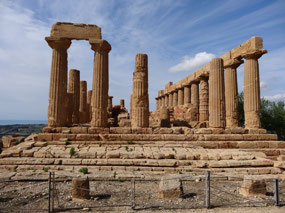
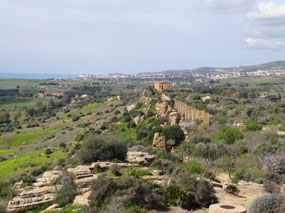
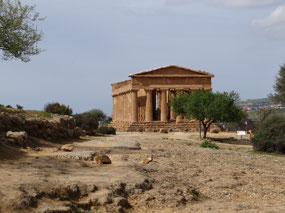
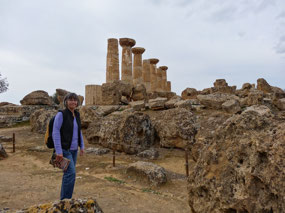
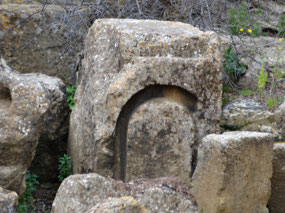
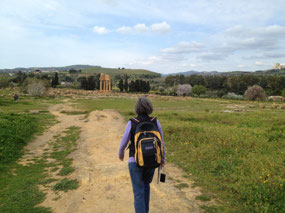
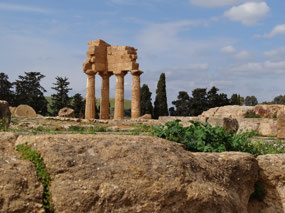
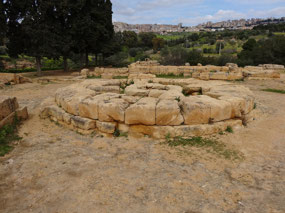
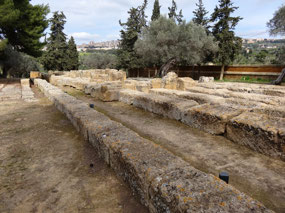
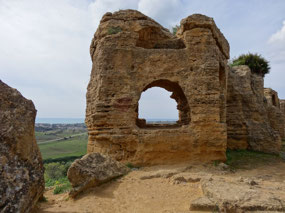
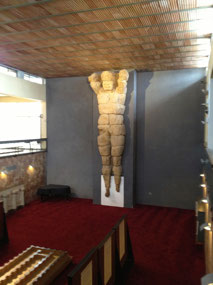
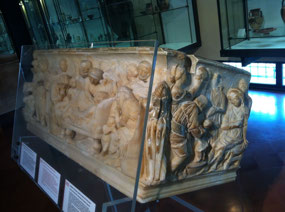
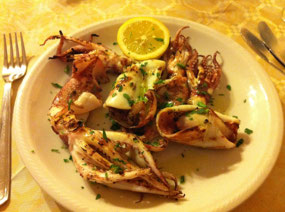




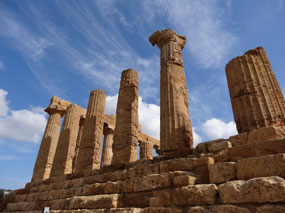
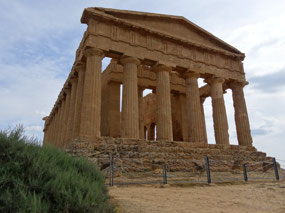

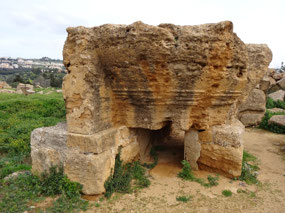
2025-05-23